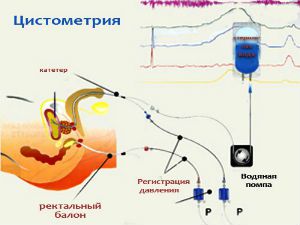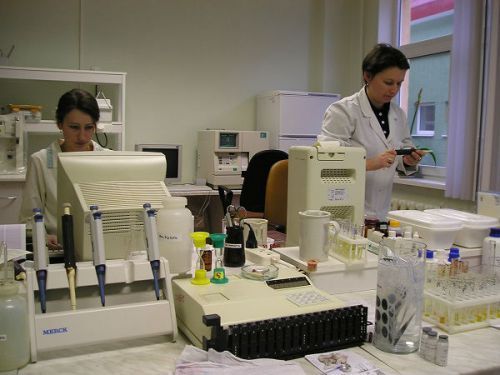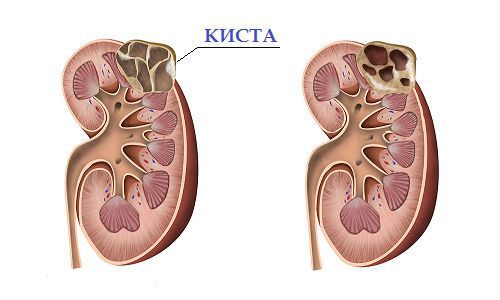The procedure gives a clear assessment of the functioning of the urethra and detrusor. This type of diagnosis among children, men and women to detect abnormalities related to the work of the authority.
For the diagnosis of various diseases of the urinary bladder in medical practice is used cystometry. In the study, the volume of the bladder, the pressure level in the body to its filling and in the empty state.
Cystometry to diagnose a malfunction of the bladder.
Indications for
Indications for carrying out the method are as follows:
- urinary incontinence;
- the inability to completely empty the body at the time of urination;
- increased frequency or urinary retention;
- enuresis;
- frequent urination with scanty urine;
- about urination;
- difficulty beginning the urinary act;
- pain in the bladder;
- preparation for surgical intervention on the organ.

For more accurate results can be assigned to additional tests such as cystography or urography.
Training
Special preparation for cystometry not required.
It is enough to conduct the following activities:
- prima antibiotics for 3-5 days before and after the procedure;
- conducting a cleansing enema;
- talk with your doctor for the moral training of the patient;
- examination of the patient to identify possible contraindications;
- food and fluid intake is not limited.
To prevent complications, the patient must inform the doctor about allergies to any medicines, latex, anesthesia. It is important to exclude bad svorachivanie blood. Medication blood thinners before the procedure is canceled for some time. It is impossible to use the method during pregnancy. Be sure to inform the doctor about the intake of certain medicines, including vitamins, nutritional supplements, contraceptives.
How is the study
Cystometry is performed by a urologist or gynecologist in a hospital. Often the procedure is performed in the planned order during examination of the patient or his stay in a medical facility.

During cystometry all the measurements are recorded by the device, are recorded in the schedule
Stages of cystometry the following:
- The physician, the patient removes his clothes, dons a special robe. Urethra, and all instruments are processed with antiseptic solution.
- At the beginning of the procedure, the patient must urinate. It is necessary for the conduct of uroflowmetry (measure the speed of urine flow). Thus it is not necessary to strain as it can affect I the accuracy of the results.
- In the next stage catheter. The procedure may be accompanied by unpleasant sensations, not to worry.
- Through a catheter introduced into the bladder fluid. The patient needs to explain their feelings, whether the urge to urinate, heat in the abdomen, discomfort, and pain.
- One side of the catheter attached to the device to cystometry that allows the capture of basic data of the study.
- With a strong urge to urinate, the device is fixed by the volume of the body. Most often natural the urge occurs when the introduction of 150 – 250 ml.
- After filling the bladder offer the patient to urinate, simultaneously recording the pressure inside the body.
- After all the studies, the catheter is removed.
To prevent infection of the urinary tract specialist assigns antibiotic therapy with medication. In the presence of discomfort in the lower abdomen after the procedure are shown with warm sitz baths.
Contraindications and possible complications
Prohibited method of investigation in the presence of the following diseases:
- an acute infectious disease of bodies of urinogenital system;
- cystitis, urethritis;
- malignant or benign growths in the bladder.
Complications are quite rare, more often pass on their own without medical intervention. Serious consequences occur very rarely.
It is important to consider contraindications of cystometry, it will help to eliminate many of the complications
Among the complications are:
- the febrile condition of the patient;
- the presence of blood in the urine;
- the infection of the urinary tract;
- pain syndrome;
- the decrease in amount of urine.
To prevent the effects of the patient is recommended to carefully consider taking antibiotics, drink more liquids (fruit drinks, herbal teas, water, juices). If the patient notices the presence of blood in the urine, you need to inform your doctor. Often it resolves on its own.
Evaluation criteria when cystometry
During the study, recorded data allowing to assess the state of the body. The sensitivity of the bladder is determined from the moment of filling body and the sensation of strong urge to use the toilet. The presence or absence of contractions of defuser (stability) determines whether there is involuntary contraction of the body at the time of filling.
Compliance – the ability of the authority to capture small intra-luminal pressure at different amounts of filling. The volume of the bladder – the size is determined by using the filling body. This number is fixed at its maximum filling. The ability of the urethra to increase the pressure in the zone of closure. Because of this on retained urine in excessive fill.
Data obtained during cystometry, experts estimated
While the study notes the following events:
- not allocated or urine when you cough of the patient is fixed in the beginning of the filling body after the procedure and every 100 ml of introduced fluid;
- the beginning of the introduction of the liquid;
- the first urge to use the toilet;
- the state of the patient’s sensations;
- a moderate urge to urinate;
- the strong desire of the patient to urinate;
- is there any involuntary leakage of urine, or its selection by coughing;
- the maximum amount of liquid during the filling of the body;
- are there any pain, discomfort, burning sensation.
Data is recorded in the log or on the chart to allow for further diagnosis, exploring the indicators of the patient.
Which urodynamic disorders defines cystometry
About deviations from the norm indicated by the following survey:
- increased sensitivity of the patient as the bladder fills. The first urge to urinate occurs when introduction of less than 150 ml of liquid;
- reduced sensitivity;
- lack of sensitivity to the duration of the session content;
- the increase in pressure of the detrusor;
- urinary incontinence, due to the increase in pressure of the detrusor;
- urinary incontinence due to increased abdominal pressure;
- micciano increased detrusor pressure;
- low urine flow rate;
- the imbalance in the contraction of the muscles of the urethra with periurethral striated muscles.
Cystometry will help to identify many abnormalities, to explain possible deviations from the norm in a particular patient, to select the most optimal treatment.
The feature of measuring the speed and volume of urine
During urination the flow of urine is gaining full speed at the moment when the detrusor pressure exceeds urethral. In clinical practice this phenomenon has a name – speed of open the urethra. This indicator fixed appliance. The following entry specifies the maximum speed of the jet. In that moment, when the pressure of the detrusor becomes lower than in the urethra, the speed drops, the body is no longer able to expel the urine – urine flow rate flat zero.
The patient should inform the doctor about their feelings during the study
The ratio of the volume and flow of urine starts when the filling of the bladder and the expression of desire by the patient to urinate.
Register here the following indicators:
- the pressure inside the bladder;
- intra-abdominal pressure;
- the pressure of the detrusor;
- indicators of pressure during maximum flow rate of urine;
- the amount of residual urine.
Studies of urine flow rate, bladder volume, pressure inside the bladder, the detrusor and in the cavity of the peritoneum allows you to diagnose many diseases of the genitourinary system.
Which indicators are the norm
About the normal functioning of the bladder evidenced by the following indicators:
- on a volume of 500-600 ml;
- residual urine is at least 50 ml;
- during coughing, the urine is not allocated;
- systolic contractions of the detrusor do not exist;
- the urge to urinate not earlier than after the administration of 150 ml;
- urine flow rate above 15 ml/s.
Figures can deviate from the norm, depending on the age of the patient and his individual characteristics. In disputed points the patient can order a repeat study after some time or other methods of examination. Obtained in the study data is evaluated by a specialist to be diagnosed.
Cytometry is a reliable method of diagnosis of many diseases related to the functioning of the bladder. Treatment should not abandon it, because in many cases, this type of research is needed. Compliance with all the rules of preparation and accounting contraindications will help avoid the negative consequences of the study to establish the diagnosis and to appoint effective treatment for the patient.




Hey, I think your blog is great! i was thinking of purchasing this fitness product but would like your feedback or from others here.